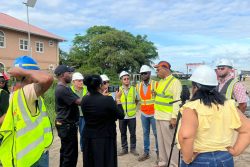Dear Editor,
There exists among us, it would seem, an attitude of what can only be calmly described as an ‘unconcern’ for the prospect, the possibility of our dear land of Guyana being reduced in size, conceding a few hundred square miles of coastland territory to the Atlantic Ocean and destroying our capital. Warned years ago of the threat, the possible disastrous effects of global warming and its accompanying or resulting changes in the type and pattern of our climatic conditions, some of us have chosen to ignore the scientific reports and have continued to maintain our established routine of life on this coastal mud-flat of ours.
Whether it is a lack of foresight or lack of knowledge of the approaching weather and climate conditions there are some who believe and accept as fact that changes will occur but not now, later, sometime later so why worry, why the fuss and hurry, there is time in which to make the necessary preparations and take this appropriate action.
With the growing number of reports of increased temperatures, unusually long, dry periods, rainfall spells of sometimes more than twenty days non-stop and inordinate flooding causing deaths, news items from many different locations, the type of climate change nature has in store for us can only be speculated on.
The physical location of Guyana’s capital just a few degrees north of the Equator with the Tropic of Cancer passing through the southern portion of the Gulf of Mexico places these two areas within an equatorial/tropical band of the earth’s surface between the tropics of Cancer and Capricorn.
Accepting as fact the concept that environmental conditions that remain basically unchanged for reasonably long periods of time can exert a conditioning influence over living organisms and creatures that also maintain their existence for reasonably long periods within the limiting area, the corollary, also taken as factual, states that the living process of organisms and creatures also exert ‘pressures’ that help to change the physical aspects of environment. These are reciprocal processes that, for various natural reasons, create what are recognizably different climatic regions with the understanding that both the character and magnitude of events, singly or in combination, may or may not change the nature, the perception of the environment in one area but may also cause a change in some other region at some later time. Scientific investigation may yet help to arrive at an understandable, better perception of the regime of change and relationships in nature.
An initial look at our Globe and its oceans and land masses rotating on its polar axis immediately raises the question of the power of gravity, the force attracting all bodies towards the molten centre of the rapidly moving earth. This force is strong; it attracts the smallest particles of matter and maintains the integrity of the earth and its surrounding atmospheric environment.
While the Earth planet is regarded as being spherical it is not a sphere. Its equatorial diameter is c.7926 miles while its Polar diameter is c.7900 miles making it what is correctly referred to as an oblate spheroid with its Equatorial circumference c.91.68 miles greater than its Polar circumference. This immediately suggests that it is the rotation, the spinning of the Earth around its Polar axis, that is pulling particles of matter towards the Equator as if to let the centrifugal spinning force fling them into space, causing also the ‘flattening’ of the Polar regions.
As it is, the destruction of the ozone gaseous layers that protected the large polar concentrations of snow and ice from the penetrating warm rays of the sun, no doubt caused by a combination of a normal cyclical act of nature, and the gaseous waste produced by the burning of fossil fuel, suggest that the impending catastrophe is due to mankind’s search for Nirvana.
It is more than likely that the molecules and particles of ice, snow in their liquid and gaseous forms as well as other free particles of matter, will respond to this centrifugal force and be moved towards the equator. In this process any lowland areas in their way will be inundated. Areas such as ours, already below sea level will disappear from the surface of the earth.
The most important remaining question is therefore, when, how soon will this happen? How much time is there left in which to move and establish our capital on a higher, safer, perhaps more centralized location – a move to greater safety that was prompted years ago in the recommendation of Premier Burnham. While the building up of such forces may be slow, the point of change, ‘explosion’ of the forces, may be sudden and calamitous.
It seems that only then will we be galvanized into action. But, ‘too late, too late shall be the cry.’ Our boat “gone-a-falls, can’t turn back’.
We must then suffer the consequences of our refusal to heed the signs and warnings and take the necessary precautionary actions.
There have been comments on the inactivity, an apparent lethargy in the administration to take positive steps on this issue but it is not entirely true to say that nothing is being done on the question of understanding the predicament we will be facing some time in the future.
The Government of Guyana has assisted in alleviating problems caused by flooding in Suriname. Under the CPACC, the Caribbean Planning for Adaptation to Climate Change, US $6.7 million worth of sea level/climate monitoring equipment was installed at the mouths of the Essequibo, Demerara and Berbice Rivers. “The equipment was supplied under the CPACC and executed by the O.A.S.”
As stated by Mr Wyllie, Director of the O.A.S. the objective was to support Caribbean countries in preparing to cope with the adverse effects of global warming and climate changes, particularly the adverse effects of sea level rise especially in coastal and marine areas.
Apart from some investigating work by Technology’s Lecturer Surveyor, this author and help from a few friends a University committee has been appointed to deal with this question but information on its work appears to have been restricted.
A recent early morning television report of the complete disappearance of an island territory in the Far East was extremely disturbing. The agitated surface of the water as the topmost leaves of trees that presumably grew near an old man’s home were recovered by the slowly rising ocean water would have been a frightening experience for all of our people with homesteads on our coastal strip settled now much more than five feet below sea level.
Archaeological and other scientific findings have told us of the continuing processes of evolutionary development, change and destruction in nature. Are we, situated as we are, many of us with living experience of the problems nature has imposed on us, are we to accept the virtually predicted destruction of our capital, our dreams, our future, without at least attempting to salvage what we can so as to re-start and continue our lives in better, healthier and a higher location with more promising prospects for ourselves, our children and our children’s children?
Yours faithfully,
R.O. Westmaas
Editor’s note
The Minister of Agriculture Mr Robert Persaud has announced the re-launching of the National Climate Change Committee with an expanded mandate and strengthened management team to deal with Guyana’s preparedness and adaptation to climate change.





